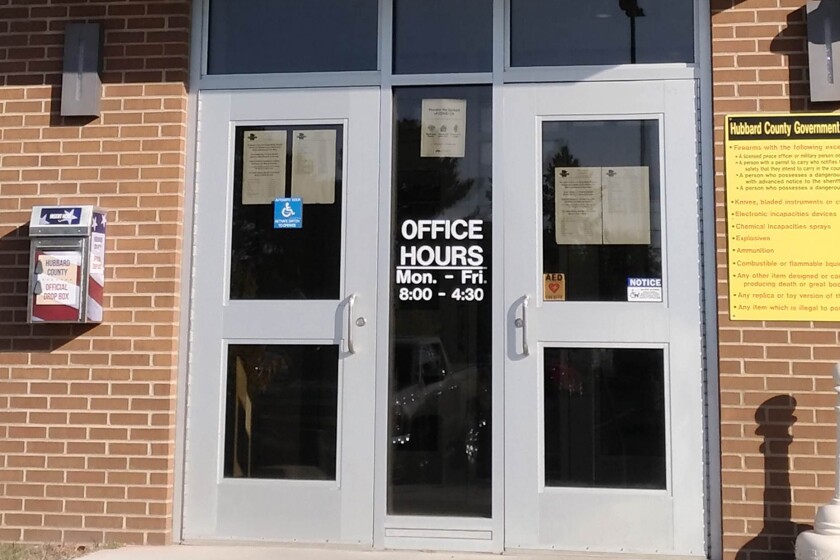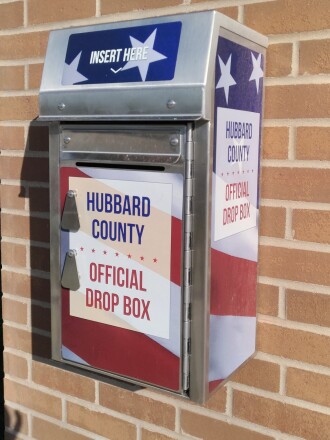Will new state law doom Hubbard County's ballot drop boxes? - Park Rapids Enterprise

Hubbard County commissioners tabled a decision whether or not to apply for a 2022 ballot drop box grant.
The funds would be used to implement security measures that are now required under state law.
They have until May 16 to apply to the Office of the Minnesota Secretary of State (SOS). They will address the issue at the Tuesday, May 3 board meeting.
In 2021, the Minnesota Legislature passed a bill setting new standards for ballot drop boxes.
When the bill was signed into law last year, Minnesota Secretary of State Steve Simon said, “As more and more Minnesota voters choose to vote early by absentee ballot, they will certainly appreciate the security and convenience that drop boxes now provide, and voters can now expect a consistent experience wherever in Minnesota they cast their ballot.
Under the state law, ballot drop boxes that provide round-the-clock access must do the following:
- Continually record on video during the absentee-voting period;
- Be designed to prevent removal or tampering;
- Be secured against damage due to weather;
- Be emptied of ballots at least once per business day.
The bill included $2 million in grants to assist counties and cities in implementing these drop box security measures.
It also provided the SOS with authority to distribute $3 million in federal funds for election security upgrades and an additional $1.5 million in state funds to replace aging election equipment as local government grants.

County Administrator Jeff Cadwell said, “There are plenty of administrators and commissioners who are saying, ‘Well, if they are putting this requirement on us, then we’re not going to accept drop boxes. People can do mail-in balloting or they can bring them into the office.”
At Tuesday’s meeting, Cadwell suggested the commissioners discuss how to proceed.
“In my mind, just because there’s money that comes with it, doesn’t mean it’s a good process,” he said.
In addition, Cadwell pointed out that it has not yet been resolved who is responsible for the data in the cloud storage. He said it should be the state, not the county. “Administratively, it creates a nightmare,” he said.
County commissioner David De La Hunt said the new law establishes standards, but doesn’t require a county to have a ballot drop box.
County commissioner Char Christenson said, “If we’re going to use the two drop boxes, why would we not want video? Because if you look at what happened at the last election – the fraud, supposably – there’s proof of this, that people did multiple drops at the drop box.”
Christenson said she supports discontinuing the ballot drop box.
De La Hunt noted the funding will likely end in the future, then the county will be responsible “for maintaining the cameras and all this stuff into perpetuity. So there is an argument for removing the drop boxes.”
He continued, “With mail-in balloting, there’s more than ample opportunity to mail your absentee ballot in. Does the county need to absorb extra expense down the line?”
De La Hunt said reviewing videos will take a lot of staff time as well.
County commissioner Ted Van Kempen wondered if someone repeatedly stops at the drop box, even though it will be video recorded, “won’t the damage, if any, have already been done?”

During the 2020 election, Hubbard County Auditor-Treasurer Kay Rave and her staff emptied the ballot drop box three to four times daily.
Rave told the board, “The volume was such that it was necessary that we empty both boxes that many times.”
A small box is located next to the front doors of the Hubbard County Government Center. A second, stand-alone drop box sits to the east of the building.
Rave said 24-hour video surveillance of both drop boxes will cost $15,000 a piece.
If awarded a grant, Hubbard County would use the funds for purchasing and installing video monitoring, along with buying data storage.
Rave noted that a majority of the county’s precincts opted for mail-in only ballots in 2020.
The 2020 election – likely due to the pandemic – also produced a record-setting number of absentee ballot requests in Hubbard County.
In Minnesota, voters can vote early by mail or in person by requesting an absentee ballot. Military and overseas Americans also vote by mailing an absentee ballot. Absentee voting begins 46 days prior to the general election.
Of the county’s approximately 13,300 registered voters, over 8,000 were either mail ballot or absentee ballot in 2020, “which we had to process here. That quantity was really more than we could handle with our team,” Rave told the board. “Thankfully, we got the DS450, which is the mass ballot counter.”
De La Hunt said, “I’m trying to rationalize why people would use a drop box over the other methods. Obviously, during the middle of the pandemic they just didn’t want to interact with people in any way. Otherwise, there’s multiple other options to get your ballot where it needs to go.”
Rave said, “As I recall, there were so many people that did not want to mail their ballots. They didn’t mind dropping them off. They could bring them in, but since there was a drop box, they were happy to use the drop box.”
Cadwell commented on the existing safety and security of election, noting that every registered voter has one ballot that is linked to that person.
“The possibility of somebody voting twice is really very difficult, unless they come in and ask for another ballot and then we should catch that. We have the checks and balances within the system. In my mind, the video isn’t going to provide us anything,” he continued.
For example, Cadwell said his wife could ask him to drop off her ballot along with his. A father-in-law could make that same request. “There’s still three good ballots by three registered voters, but one person’s dropping them off,” Cadwell said.
He questioned the effectiveness of video surveillance.
“I don’t think this gives us any protection that we don’t already have relative to election security and making sure the ballots are cast by people who are certified and registered to vote in the county,” Cadwell said.
Removing ballot drop boxes “is the simplest answer. It eliminates the concern. It eliminates the need, and it eliminates the additional expense and administration,” he concluded.
County commissioner Tom Krueger added, “Being a proponent of not only voting in person but voting with a voter ID, drop boxes don’t fit into that picture at all.”
Christenson agreed.
Instead of removing the drop boxes, Cadwell said the county could simply post them as “not for ballots.”
Christenson asked if voters could drop ballots off at the security checkpoint in the courthouse.
Rave said voters will have to go through security and go to the auditor’s office.
“They have to be dropped off with qualified election staff,” Cadwell added.
Christenson calculated it only takes five minutes to bring a ballot into the office. “It is a privilege to vote, and if people want to vote, they’re going to go through that,” she said.
Van Kempen speculated that few people from the northern part of the county drive to Park Rapids to drop off their ballots.
Rave countered that, saying, “There are some that make a point to drive here to deliver their ballots or use the drop box.”
Cadwell said “a lot of public education” will be needed. The drop boxes will need new signs, but residents may use them for other official business, such as property tax payments.
He asked for time to develop a policy with Hubbard County Attorney Jonathan Frieden’s input.
Van Kempen said, “Even with all the signage in the world, there's still going to be somebody that's going to drop their ballot in the box.”
Cadwell agreed a policy will need to be developed for spoiled ballots.
Rave explained her office is required to contact that voter, alerting them to a spoiled ballot and issuing a new one.
“But that does really increase the level of work on our staff,” she added.
Mail-in voting began during the Civil War when both Union and Confederate soldiers were given the opportunity to cast ballots from their battlefield units and have them be counted back home in the 1864 election.
Absentee voting re-entered the national conversation during World War II. The Soldier Voting Act of 1942 permitted all members of the military overseas to send their ballots from abroad. The act was amended in 1944 and expired at war’s end, but other legislation was passed: The Federal Voting Assistance Act of 1955, the Uniformed and Overseas Citizens Absentee Voting Act in 1986 and the Military and Overseas Voter Empowerment Act in 2009.
In 1974, Washington state was the first to offer no-excuse absentee voting.
In 2000, Oregon became the first all vote-by-mail state. Washington did the same in 2011 and Colorado did in 2013.
source: https://www.parkrapidsenterprise.com/news/local/will-new-state-law-doom-hubbard-countys-ballot-drop-boxes
Your content is great. However, if any of the content contained herein violates any rights of yours, including those of copyright, please contact us immediately by e-mail at media[@]kissrpr.com.

